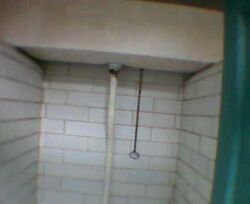Engineering:Flushing trough
A flushing trough is a long cistern which serves several toilet pans. It is designed to allow more frequent flushing.
Uses
Flushing troughs are commonly used in places such as schools, colleges, public toilets, factories and public buildings where quick refill of the flushing cistern is required. Siphonic action is started in the same way as an ordinary flushing cistern. As the water is siphoned, the water level falls only inside a timing box designed to permit the required flush. When the timing box has been emptied of water, air enters through an air pipe to break the siphonic action. The timing box refills with water through a hole in its side. The cistern is then ready to flush.
Background
The patent had been submitted by Shanks in 1934 and advertisements reveal 25.000 in use by 1939. Two known manufacturers where Shanks who sold it as the 'Alisa' and also Fordham and they were intended to serve schools or places where toilets would be of high use. The cistern was made of cast iron or galvanised steel and could serve 2, 3 or 4 toilets. To flush the cistern, the chain that connects to the siphon is over the front ort the rear of the cistern although water may sometimes slightly splash over the top. A concealed variant was also available located in a 'duct' behind the wall to prevent vandalism and so that maintenance could be carried out without entering the public space. A third version passes the chain through the cistern. The chain extended through a pipe higher than the water level and overflow level and thus no water would be splashed over the side while in use. Most flushing troughs had a longer life span than a standard single cistern. The main disadvantage is that maintenance requires all WCs served by the Trough to be unavailable.
Such troughs were used by local councils in the UK into the 1980s.
This article does not cite any external source. HandWiki requires at least one external source. See citing external sources. (2021) (Learn how and when to remove this template message) |
 |





